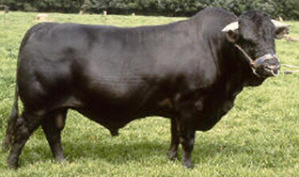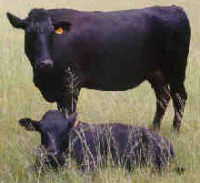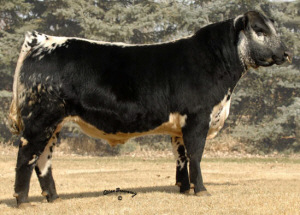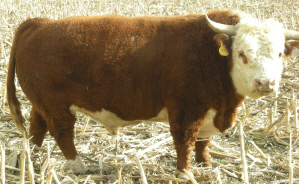



Drakensberger
History
The Drakensberger is indigenous to South Africa and was developed over a period of several centuries. After Vasco da Gama rounded the Cape in 1497 he briefly went ashore to acquire a black ox from the local native people in exchange for three bracelets. Da Gama subsequently paid tribute to the excellent quality of its meat. This is history's first recording of the black cattle of the Cape. Photo courtesy of The Drakensberger Cattle Breeders' Society of South Africa, www.studbook.co.za/Society/drakensberger |
This name remained unchanged until 1947 when the Drakensberger Cattle Breeders Society of South Africa was formed to receive immediate official recognition. By that time the black cattle had become known as Drakensbergers because of their widespread concentration in the mainly sourveld Drakensberg region, beginning at Dordrecht in the Cape and stretching east and north over a distance of more than a thousand kilometres.
Today the breed has spread throughout the country, from Humansdorp in the south, through the eastern Free State, KwaZulu-Natal and eastern Mpumalanga to Messina in the Northern Province.
Although the Drakensberger has always thrived extremely well on sourveld grazing, of late it has been found to do even better in the sweetveld areas, as a result of which the breed has been moving in substantial numbers into the North-West Province and north western Free State and into the mountainous areas of the Karoo.
Interest in the Drakensberger around the world is steadily increasing, there have already been steady inquiries about the breed from as far afield as the United States, Canada, Brazil and Mozambique, with exports to Zimbabwe, Namibia and Swaziland.
The declared mission of Drakensberger farmers is to propagate the traditional black animals carrying a maximum amount of high quality beef without sacrifice of the breed's inherent qualities.
Characteristics
 Photo courtesy of The Drakensberger Cattle Breeders' Society of South Africa, www.studbook.co.za/Society/drakensberger |
Mature bulls weigh from 820 kg to 1100 kg, and cows from 550 kg to 720 kg, calves weigh approximately 35 kgs at birth. Cows remain in production for up to 20 years.
This breed is a damline breed where emphasis is put on female traits such as calving ease, fertility, milk, maternal instincts.
Another special merit of the breed is its ability to cross well with both Bos indicus and Bos taurus breeds, making it exceptionally suitable as a motherline breed in crossbreeding systems.
Statistics
Comparative
Trials conducted by JF de Bruyn et. Al. (1989) on a different breed groupings viz., Zebu-, British-, European breeds and the Drakensberger, showed the Drakensberger to have the juiciest and most tasty (flavourful) meat with the best cut ability. The dressing percentage was second only to the European breed whilst statistically higher that the Zebu- and British breeds.Distribution
The production of the Drakensberger is mainly in Africa, at present about 14000 purebred Drakensberger females and 5300 males are registered, and on average new registrations made annually number 2700 females and 2800 males.References (the above information was cited from the following sites)
www.studbook.co.za/Society/drakensberger


